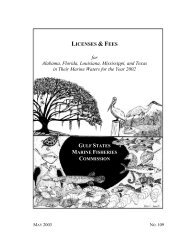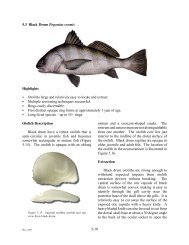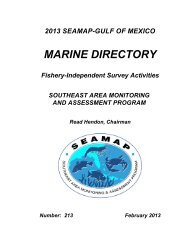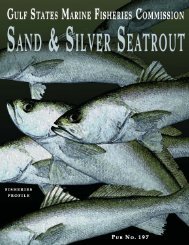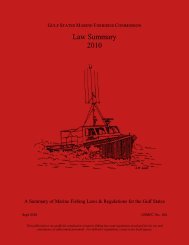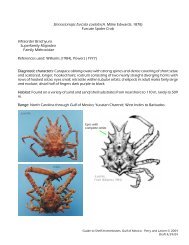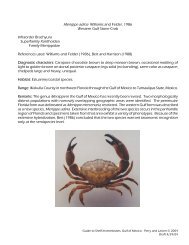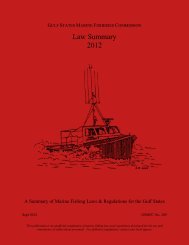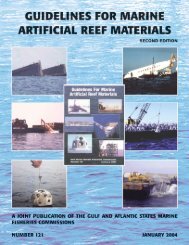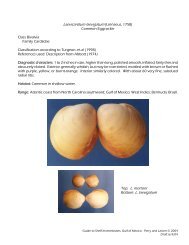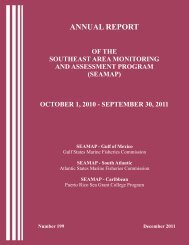Basic Commercial Fishing Regulations - Gulf States Marine ...
Basic Commercial Fishing Regulations - Gulf States Marine ...
Basic Commercial Fishing Regulations - Gulf States Marine ...
Create successful ePaper yourself
Turn your PDF publications into a flip-book with our unique Google optimized e-Paper software.
Wire Net: mesh size must not be less than one square<br />
inch or two inches stretched.<br />
All gill nets and trammel nets must be tagged with<br />
a waterproof tag attached to the corkline at each end of<br />
the net, no more than three feet from the edge of the<br />
webbing. The tags must contain the fisherman’s full<br />
name (no initials) and commercial fisherman’s license<br />
number. The tags are to be supplied by the commercial<br />
fisherman.<br />
Freshwater Areas Closed to Netting<br />
Use of gill nets, trammel nets and fish seines are<br />
prohibited in the following waterbodies:<br />
• Caddo Lake<br />
• False River Lake<br />
• Lake Concordia<br />
• D’Arbonne Lake<br />
• Lake Bartholomew<br />
• Lake Claiborne<br />
Use of gill nets, trammel nets, fish seines and hoop<br />
nets are prohibited in the following waterbodies:<br />
• Anacoco Bayou (that portion between Anacoco<br />
Lake and Lake Vernon)<br />
• John K. Kelly-Grand Bayou Reservoir (wire nets<br />
prohibited also)<br />
• Caney Creek Reservoir<br />
• Anacoco Lake<br />
• Bundicks Lake<br />
• Chicot Lake<br />
• Cross Lake<br />
• Lake Bistineau<br />
• Lake Vernon<br />
Toledo Bend Reservoir (Louisiana portion): Hoop<br />
nets are prohibited March 1 - May 15 each year only<br />
in that portion of Toledo Bend Reservoir from a point<br />
north of Logansport where the lake enters Texas, and<br />
south to a point on the lake where the Texas Duck<br />
Refuge Canal intersects the Old Channel of the Sabine<br />
River.<br />
Louisiana fishermen using slat traps or slat baskets in<br />
Mississippi border waters are required to obtain tags<br />
from the Mississippi Department of Wildlife, Fisheries<br />
and Parks.<br />
Freshwater Fish Species Prohibited<br />
No person may possess or sell in this state the following<br />
fishes: all species of piranha, tilapia and carp,<br />
except koi or common carp (Cyprinus carpio) and<br />
goldfish (Carassius auratus); Rio Grand cichlid;<br />
freshwater electric eel (Electrophorus sp.); rudd<br />
(Scardinius erythrophthalmus); all members of the<br />
families Synbranchidae (Asian swamp eels),<br />
Channidae (snakeheads), Clariidae (walking catfishes)<br />
and Trichomycteridae (pencil catfishes).<br />
Asian carp (grass carp (Ctenopharyngodon idella),<br />
silver carp (Hypophthalmichthys molitrix), bighead<br />
carp (Hypophthalmichthys nobilis) and black carp<br />
(Mylopharyngodon piceus)) taken in state waters may<br />
be possessed and sold by properly permitted commercial<br />
fishermen or by any commercial fisherman provided<br />
the fish is dead.<br />
Freshwater Musseling<br />
Areas Closed to Freshwater Musseling<br />
A. Areas officially recognized as saltwater areas.<br />
B. Amite River from the junction with Bayou<br />
Manchac to the Mississippi State Line.<br />
C. All of Rapides and Grant Parishes except the main<br />
channel of the Red River.<br />
D. Bayou Bartholomew in Morehouse Parish from<br />
the Arkansas state line to its confluence with the<br />
Ouachita River.<br />
E. Additional areas may be closed at any time by<br />
notice from the Secretary.<br />
Mussel Harvester Permit: A freshwater mussel harvester<br />
is required to purchase a <strong>Commercial</strong> <strong>Fishing</strong><br />
License and a Mussel Harvester Permit to commercially<br />
harvest mussels.<br />
Notice Concerning <strong>Fishing</strong> in<br />
Louisiana/Mississippi Border Waters<br />
When commercial fishing in Mississippi border<br />
waters, as defined in “Reciprocal License Agreement<br />
- Mississippi & Louisiana, November 2000” (copy<br />
available upon request), trot lines, snag lines, hoop<br />
nets, gill nets and trammel nets may be tagged with a<br />
waterproof tag containing the fisherman’s full name<br />
(no initials) and commercial fisherman’s license number,<br />
in lieu of tags required by Mississippi regulations.<br />
The tag shall be placed within five feet of one end on<br />
trot and snag lines, on the first hoop on hoop nets, and<br />
on the float line within five feet of one end on gill and<br />
trammel nets. Fishermen shall supply their own tags.<br />
20<br />
118



